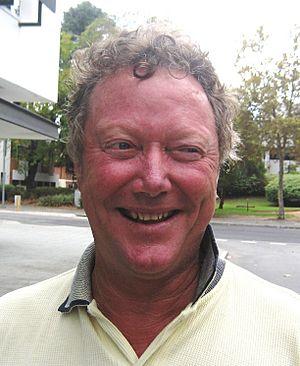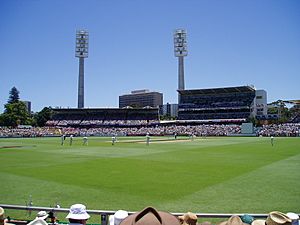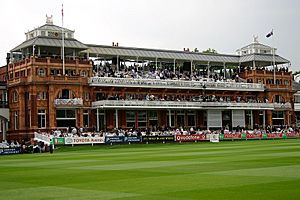Kim Hughes facts for kids

Hughes in 2009
|
||||||||||||||||||||||||||||||||||||||||||||||||||||||||||||||||||
| Personal information | ||||||||||||||||||||||||||||||||||||||||||||||||||||||||||||||||||
|---|---|---|---|---|---|---|---|---|---|---|---|---|---|---|---|---|---|---|---|---|---|---|---|---|---|---|---|---|---|---|---|---|---|---|---|---|---|---|---|---|---|---|---|---|---|---|---|---|---|---|---|---|---|---|---|---|---|---|---|---|---|---|---|---|---|---|
| Full name |
Kimberley John Hughes
|
|||||||||||||||||||||||||||||||||||||||||||||||||||||||||||||||||
| Born | 26 January 1954 Margaret River, Western Australia |
|||||||||||||||||||||||||||||||||||||||||||||||||||||||||||||||||
| Nickname | Claggy | |||||||||||||||||||||||||||||||||||||||||||||||||||||||||||||||||
| Height | 182 cm (6 ft 0 in) | |||||||||||||||||||||||||||||||||||||||||||||||||||||||||||||||||
| Batting | Right-handed | |||||||||||||||||||||||||||||||||||||||||||||||||||||||||||||||||
| Bowling | Right-arm medium | |||||||||||||||||||||||||||||||||||||||||||||||||||||||||||||||||
| Role | Top-order batsman | |||||||||||||||||||||||||||||||||||||||||||||||||||||||||||||||||
| Relations | Glenn Hughes (brother) | |||||||||||||||||||||||||||||||||||||||||||||||||||||||||||||||||
| International information | ||||||||||||||||||||||||||||||||||||||||||||||||||||||||||||||||||
| National side |
|
|||||||||||||||||||||||||||||||||||||||||||||||||||||||||||||||||
| Test debut (cap 281) | 25 August 1977 v England | |||||||||||||||||||||||||||||||||||||||||||||||||||||||||||||||||
| Last Test | 27 December 1984 v West Indies | |||||||||||||||||||||||||||||||||||||||||||||||||||||||||||||||||
| ODI debut (cap 37) | 4 June 1977 v England | |||||||||||||||||||||||||||||||||||||||||||||||||||||||||||||||||
| Last ODI | 29 March 1985 v India | |||||||||||||||||||||||||||||||||||||||||||||||||||||||||||||||||
| Domestic team information | ||||||||||||||||||||||||||||||||||||||||||||||||||||||||||||||||||
| Years | Team | |||||||||||||||||||||||||||||||||||||||||||||||||||||||||||||||||
| 1975/76–1988/89 | Western Australia | |||||||||||||||||||||||||||||||||||||||||||||||||||||||||||||||||
| 1989/90–1990/91 | Natal | |||||||||||||||||||||||||||||||||||||||||||||||||||||||||||||||||
| Career statistics | ||||||||||||||||||||||||||||||||||||||||||||||||||||||||||||||||||
|
||||||||||||||||||||||||||||||||||||||||||||||||||||||||||||||||||
|
Source: CricketArchive, 14 April 2008
|
||||||||||||||||||||||||||||||||||||||||||||||||||||||||||||||||||
Kimberley John Hughes (born 26 January 1954) is a famous former cricketer from Australia. He played for Western Australia, Natal, and the Australian national team. Kim Hughes was the captain of Australia in 28 Test matches between 1979 and 1984. Later, he led an Australian cricket team on a tour of South Africa during a time when many countries were boycotting sports there to protest against the country's policies.
Hughes was a right-handed batsman known for his elegant and attractive batting style. He was seen as a future Test star from a young age. However, his adventurous batting and some disagreements with influential teammates meant he started his first-class and Test career a bit later than expected. During a big split in Australian cricket, when some players joined a new competition called World Series Cricket, Hughes chose to stay with the traditional cricket board.
His time as Australia's captain was challenging. Many matches were played away from home, and he had to lead a young team after several experienced players left. He faced a lot of pressure from the media and former teammates during a series of losses to the strong West Indies team. Hughes eventually resigned as captain, giving an emotional speech. He finished his playing career in South Africa.
After retiring from playing, Hughes served as the chairman of selectors for the Western Australian Cricket Association for a time. He also sometimes works as a commentator for ABC Radio's cricket broadcasts.
Contents
Kim Hughes: Australian Cricket Star
Early Life and Cricket Beginnings
Kim Hughes was born on 26 January 1954, in Margaret River, Western Australia. His father, Stan, was a school teacher, and his mother was Ruth. The family moved around Western Australia because of his father's job, eventually settling in Geraldton.
As a child in Geraldton, Hughes enjoyed many sports, including hockey, tennis, and especially Australian rules football. He started playing organized cricket at age 11, filling in for an under-16 team. His talent was noticed when he played in junior tournaments in Perth against older boys.
After primary school, his family moved to Perth, where Hughes attended City Beach High School. He continued to excel in junior cricket, scoring many runs and taking wickets. At 15, he made his debut in first grade for Subiaco-Floreat Cricket Club. He scored his first century in first grade cricket that season.
Cricket Career Highlights
First-Class Debut

After playing only nine first grade games, Hughes was selected for the Sheffield Shield squad for Western Australia in 1970–71. He faced some challenges in the next few seasons, struggling to score runs and being left out of the state squad.
In 1973–74, Hughes was called up to the Western Australian squad again. He was eager to play at a higher level. He finally made his first-class cricket debut for Western Australia in November 1975 against New South Wales at the WACA Ground. In this match, he scored an impressive 119 runs, hitting the ball powerfully. He was the fifth Western Australian batsman to score a century in his first-class debut for the state. Later that season, he scored another century against the touring West Indians.
Test Debut and World Series Cricket
Hughes' strong performances caught the attention of national selectors. He was called up as the twelfth man for Australia in a Test match in January 1977. He made his official Test debut in August 1977 against England.
Around this time, there was a major split in Australian cricket. A new competition called World Series Cricket (WSC) was created by Kerry Packer, and many top players signed contracts to join it. Hughes, however, chose to stay with the traditional Australian Cricket Board (ACB). This meant he played alongside older, returning players and new, inexperienced ones.
A Young Captain
In 1978–79, with many experienced players gone to WSC, Hughes played in all six Tests against England, scoring his first Test century (129 runs) in Brisbane.
Later that season, Hughes was named Australian captain for the second Test against Pakistan. He was only playing his eleventh Test match. He led the team to a win, tying the series. During this match, there were some unusual dismissals. One player was run out when he left his crease before the bowler delivered the ball (called "Mankading"), and another was given out for touching the ball after it had been returned by a fielder (called "handling the ball"). These actions, while allowed by the rules, sparked debate about sportsmanship.
Hughes then captained Australia in the 1979 Cricket World Cup and on a Test tour of India. In India, he showed great skill against spin bowling and scored 594 runs, including a century, proving his ability to lead and perform.
Reunification and Great Innings
"One of [my mother's] most prominent early memories of me is when I was sitting on the lounge-room floor, eyes fixed on the television, watching Kim Hughes bat. Kim was my first hero in Test cricket, a batsman who, when he was on, was unstoppable. I remember him taking on the West Indies at the MCG the week after my seventh birthday, their fast bowlers aiming at his chest and head, him hooking and pulling fearlessly. That knock stays burned in my memory and probably set the standard for the sort of cricketer I wanted to become."
In 1979, the World Series Cricket players returned to the traditional Australian team. Hughes became vice-captain under Greg Chappell. He started the summer strongly, scoring 139 not out against a powerful West Indies team.

The Centenary Test at Lord's Cricket Ground in August 1980 was a memorable match for Hughes. He scored a century (117 runs) in the first innings and a brilliant 84 runs in the second. One of his sixes landed on the top deck of the pavilion, a very rare feat. His performance earned him the Man of the Match award and he was later named one of the 1981 Wisden Cricketers of the Year.
In 1981, Hughes scored an amazing 213 runs against India, his highest Test score. He dedicated this innings to his newborn twin sons.
Captaincy Challenges
Hughes was again appointed captain for the 1981 Ashes series in England. Australia won the first Test and drew the second. However, in the third Test at Headingley, Australia was in a strong position but famously lost after an incredible comeback by England's Ian Botham and Bob Willis. Australia went on to lose the series.
When Greg Chappell returned as captain, Hughes became vice-captain again. He scored a century (106) against Pakistan. Later, against the strong West Indies team, Hughes played another outstanding innings, scoring 100 runs on a difficult pitch at the Melbourne Cricket Ground. This innings is ranked among the Top 100 Test Innings of all time.
In 1982, Hughes captained Australia on a difficult tour of Pakistan, where the team faced illnesses and lost the series. He hoped to remain captain for the 1982–83 Ashes series at home, but Chappell was reappointed. Hughes, however, batted exceptionally well, scoring 469 runs and helping Australia win back the Ashes. After this series, Chappell retired, and Hughes became captain of a full-strength Australian team for the first time.
Resignation as Captain
In 1983, Hughes captained Australia in the 1983 Cricket World Cup. The team did not perform well, and Hughes faced criticism for sitting out a crucial match due to a minor injury. Despite this, he was reappointed captain for the 1983–84 series against Pakistan, which Australia won comfortably. At the end of that season, key experienced players like Greg Chappell, Dennis Lillee, and Rod Marsh retired.
Hughes then led a new, less experienced Australian team on a challenging tour of the West Indies in 1984. The team struggled with injuries and lost the series. Hughes himself did not score many runs, and the pressure on him grew.
When the West Indies toured Australia in 1984–85, the Australian team continued to struggle. After a heavy loss in the first Test and another difficult start in the second Test, Hughes decided to resign as captain. At a press conference on 26 November 1984, Hughes read a letter explaining his decision:
The Australian Cricket Captaincy is something that I've held very dear to me. However playing the game with total enjoyment has always been of the greatest importance. The constant speculation, criticism and innuendo by former players and sections of the media over the past 4–5 years have finally taken their toll. It is in the interests of the team, Australian Cricket and myself that I have informed the ACB of my decision to stand down as Australian Captain. I look forward to continuing my career in whichever capacity the selectors and the Board see fit with the same integrity and credibility I have displayed as Australian captain.
Hughes became very emotional and tearful while reading his resignation letter, showing how much the captaincy meant to him.
Hughes played two more Test matches under the new captain, Allan Border, but struggled with his batting. He never played in a Test match again.
Rebel Tours and Retirement
In 1985, Hughes chose to join a 'rebel' Australian team that toured South Africa. At that time, South Africa had policies that separated people based on race, called apartheid. Because of these policies, many international sports teams, including cricket teams, refused to play there as a protest. Hughes' decision to play in South Africa was controversial.
Hughes explained his decision by saying he wanted to understand the situation better and share his experiences with people back home. His decision was met with strong criticism from many people, including important leaders, who felt it went against efforts to end unfair policies in South Africa.
The rebel team played two series against South Africa, in 1985–86 and 1986–87. Hughes performed well with the bat in these series. In 2007, Hughes reflected on his participation, saying he was pleased to be involved in how cricket developed in South Africa.
After the rebel tours, Hughes returned to Western Australia. He faced a challenge from the Western Australian Cricket Association, but he won a legal case to continue playing club cricket. He played a few more seasons for Western Australia. In 1989, he became captain of Natal in South Africa. He retired from all first-class cricket in February 1991.
Off the Field
Personal Life
After high school, Kim Hughes trained to be a primary school teacher. He later worked in the finance industry, where his employers supported his cricket career.
Hughes was also a talented Australian rules football player as a junior. He played for the Claremont Football Club but eventually chose to focus on cricket.
He met Jenny Davidson when he was 14, and they married in March 1977. They have twin sons, Sean and Simon, and later had another son and a daughter. His brother, Glenn Hughes, also played first-class cricket.
Since retiring from playing, Hughes has served as chairman of selectors for the Western Australian Cricket Association and is an occasional cricket commentator for ABC radio. He was also Head of Cricket at Hale School in Perth. A dining room at the WACA Ground is named the Kim Hughes Room in his honor.
Style and Personality
Hughes was known for his exciting and stylish batting. He had a wide range of shots and played with great enthusiasm. His batting was described as having a high backlift, quick footwork, and powerful follow-through, all signs of a great stroke-player.
Many people who knew Hughes described him as a friendly and likeable person. He was popular with the press and the public, always willing to answer questions. He projected a confident image on the field, which some admired.
Hughes was very proud to be Australian. He often wore his Australian team blazer and celebrated national achievements with great joy. His nickname was "Claggy," a reference to a type of glue often found in classrooms.

